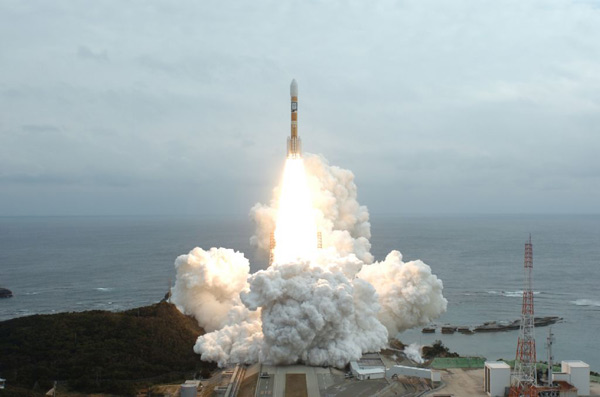Japan Launches New Satellite on Dual Mission

Air traffic controllers andmeteorologists in Japan have a new tool at their disposal after today'ssuccessful launch of a new satellite that will conduct a dual mission to serveboth communities for the next decade.
As the second member of Japan's Multi-Functional Transport Satellite fleet, MTSAT-2 will join another craft launched oneyear ago to aid in air traffic management and weather forecasting throughoutthe eastern Asia and western Pacific regions.
MTSAT-2 was delivered intospace by an H-2A rocket that lifted off from the Yoshinobu launch complex atthe Tanegashima space center on the southern end of the Japanese island chain.Launch occurred at 3:27 p.m. local time, or 1:27 a.m. EST (0627 GMT).
The final countdown tickedalong as planned, and every milestone was successfully completed near theslated time. The 174-foot (53-meter) tall launcher rolled from its integrationbuilding to its seaside launch pad about twelve hours prior to blastoff.Fueling of the first and second stages with liquid hydrogen and liquid oxygenpropellants was finished with six hours to spare.
In addition to the coretwo-stage vehicle, the mission required the maximum of six solid rocketboosters to deliver the 10,000-pound (4,535-kilogram) craft into orbit. Officialssay MTSAT-2 is the heaviest individual satellite ever launched by Japan.
After tracking southeastacross the Pacific Ocean, the launcher's second stage released the satellite asprogrammed about 28 minutes after liftoff, and a ground station in Chilereceived the first signals from the new spacecraft ten minutes later. Therocket performed as expected and delivered the payload into geostationarytransfer orbit. The planned orbit had a high point of 22,300 miles (35,888kilometers), a low point of 155-mile (249-kilometer), and an inclination of28.5 degrees.
One of the first activitiesto bring MTSAT-2 online was to partially deploy the satellite's solar panel toproduce enough electricity to charge the craft's batteries during the criticalcommissioning and orbit-raising phase. Three burns of an on-board kick motorwill place the spacecraft into a circular geostationary orbit some 22,300 mileshigh within the next three days. In five days, MTSAT-2 should have fullyextended its solar panel and antennas so it can begin a series of tests beforebeing declared operational for the Japan Civil Aviation Bureau and JapanMeteorological Agency.
Breaking space news, the latest updates on rocket launches, skywatching events and more!
Once testing is complete,MTSAT-2 will settle into its permanent parking spot in geostationary orbitalong the Equator at 145 degrees East longitude, or directly over Micronesia in the western Pacific.
Built by MitsubishiElectric, the spacecraft carries Ku-band, Ka-band, and L-band instruments tohelp make air travel more efficient and safer in the Far East and along crowdedtrans-oceanic routes over the northern Pacific linking Asia with North America. The two-satellite MTSAT system is a critical part of a new air trafficcontrol concept using space assets and relay stations to assist controllers intracking and communicating with aircraft.
The satellite will providedirect voice and data links from control centers to the cockpits of airliners -a vast improvement over the previous heavy reliance on ground-based antennaswith limited range. The MTSAT spacecraft will also help enhance the navigation datagathered by Global Positioning System satellites, and automatically transmitthat positioning data to air traffic controllers using its data relaycapability when aircraft are beyond the range of radar sites.
During the ten-yearmission, the combined effect of these improvements should expand the airspacecapacity across Japan and the adjacent waters of the Pacific, where crowdedskies have caused difficulties for controllers. Precise navigation informationwill be available at air traffic control consoles on radar screens, and directcommunications will be more consistent between pilots and the ground.
MTSAT-2's secondoperational objective is to serve as a weather observatory for Japaneseforecasters. The new satellite's sensors will be in a backup mode until around2010, when MTSAT-1R's meteorological payload surpasses its planned five-yearservice life. At that point, MTSAT-2 will assume a primary role in weatherobservations, with the older craft trading spots and entering a standby mode.
The craft features animager with five total observation channels - four in infrared and one in thevisible wavelength. Upgrades from earlier weather satellites include twice asmany imaging cycles, an improved ability to discern low-level clouds and fog,and making more accurate sea surface temperature estimates at night.
MTSAT-2 will also collectweather, seismic, and tidal reports from remote observation posts for relay tocentral forecasting centers for analysis by scientists.
Today's flight marked theninth time the H-2A rocket took to the skies since it debuted in 2001, andeight of those missions ended in success. This launch used the "2024"version of the launcher with two large solid rocket boosters and four smallerstrap-on motors due to the heavy weight of its space-bound payload.
The contract for the launchof MTSAT-2 was signed in February 2003 between launch provider Rocket SystemCorporation and the craft's operators - the Japan Civil Aviation Bureau and theJapan Meteorological Agency.
The H-2A rocket's nextlaunch is currently scheduled for no earlier than July with a pair ofreconnaissance satellites to replace those lost in the failure of an H-2Aflight in November 2003. Within the next twelve months, two more H-2A missionsare manifested with the ETS-8 engineering test satellite and another spysatellite twosome.
- Japan Successfully Returns H-2A Rocket to Flight
Join our Space Forums to keep talking space on the latest missions, night sky and more! And if you have a news tip, correction or comment, let us know at: community@space.com.
Stephen Clark is the Editor of Spaceflight Now, a web-based publication dedicated to covering rocket launches, human spaceflight and exploration. He joined the Spaceflight Now team in 2009 and previously wrote as a senior reporter with the Daily Texan. You can follow Stephen's latest project at SpaceflightNow.com and on Twitter.
